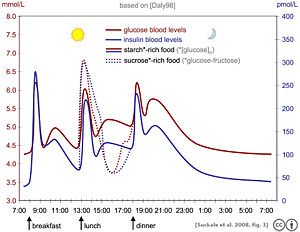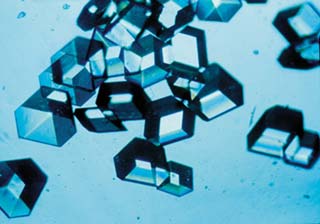Insulin
From Wikipedia, the free
encyclopedia
Jump to:
navigation,
search
Not to be
confused with
inulin.


The idealised
diagram shows the fluctuation of
blood
sugar (red) and the sugar-lowering hormone insulin (blue) in humans
during the course of a day containing three meals. In addition, the effect of a
sugar-rich
versus a starch-rich
meal is highlighted.
Insulin
is a hormone
with intensive effects on both metabolism and several other body systems (eg,
vascular compliance). Insulin causes most of the body's cells to take up
glucose from
the blood
(including liver,
muscle, and
fat tissue
cells), storing it as
glycogen in
the liver and muscle, and stops use of fat as an energy source. When insulin is
absent (or low), glucose is not taken up by most body cells and the body begins
to use fat as an energy source (ie, transfer of lipids from adipose tissue to
the liver for mobilization as an energy source). As its level is a central
metabolic control mechanism, its status is also used as a control signal to
other body systems (such as
amino acid
uptake by body cells). It has several other
anabolic
effects throughout the body. When control of insulin levels fail,
diabetes mellitus results.
Insulin is used medically to
treat some forms of
diabetes mellitus. Patients with
Type 1 diabetes mellitus depend on external insulin (most commonly
injected subcutaneously) for their survival because the hormone is no longer
produced internally. Patients with
Type 2 diabetes mellitus are
insulin resistant, have relatively low insulin production, or both; some
patients with Type 2 diabetes may eventually require insulin when other
medications fail to control blood glucose levels adequately.
Insulin is a
peptide hormone composed of 51
amino acid
residues and has a
molecular weight of 5808
Da.
It is produced in the
Islets of Langerhans in the
pancreas.
The name comes from the
Latin insula
for "island".
Insulin's structure varies
slightly between
species of animal. Insulin from animal sources differs somewhat in
'strength' (i.e., in
carbohydrate metabolism control effects) in humans because of those
variations. Porcine (pig)
insulin is especially close to the
human version.

No
higher resolution available.
Insulincrystals.jpg
(320 × 224 pixels, file size: 13 KB, MIME type: image/jpeg)
Structure
Within vertebrates, the
similarity of insulins is extremely close.
Bovine insulin
differs from human in only three
amino acid
residues, and porcine
insulin in one. Even insulin from some species of fish is similar enough to
human to be clinically effective in humans. Insulin in some invertebrates (eg,
the c elegans nematode) is quite close to human insulin, has similar
effects inside cells, and is produced very similarly. Insulin has been strongly
preserved over evolutionary time, suggesting its centrality in animal metabolic
control. The C-peptide of proinsulin (discussed later), however, differs much
more amongst species; it is also a hormone, but a secondary one.
Mechanism
Insulin is produced in the
pancreas,
and released when any of several stimuli are detected. These include protein
ingestion, and glucose in the blood (from food which produces glucose when
digested -- characteristically this is
carbohydrate, though not all types produce glucose and so an increase in
blood glucose levels). In target cells, they initiate a
signal transduction which has the effect of increasing
glucose
uptake and storage. Finally, insulin is degraded, terminating the response.
Insulin
http://www.fda.gov/diabetes/insulin.html (Click
here for more info )
Background
Information about Insulin
Many
people with diabetes take insulin to control their blood sugar (glucose).
Insulin cannot be taken by mouth because it would be destroyed by digestion.
Instead, most people who need insulin take insulin shots. Other ways to take
insulin include insulin pens, insulin jet injectors, and insulin pumps. Someday
people with diabetes may no longer need needles or shots to take insulin;
researchers are testing news ways to get insulin into the bloodstream.
When we
eat, our bodies break food down into organic compounds, one of which is glucose.
The cells of our bodies use glucose as a source of energy for movement, growth,
repair, and other functions. But before the cells can use glucose, it must move
from the bloodstream into the individual cells. This process requires insulin.
Insulin is
produced by the beta cells in the islets of Langerhans in the pancreas. When
glucose enters our blood, the pancreas should automatically produce the right
amount of insulin to move glucose into our cells. People with type 1 diabetes
produce no insulin. People with type 2 diabetes do not always produce enough
insulin.


